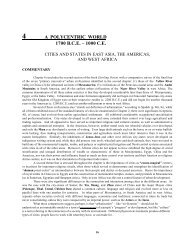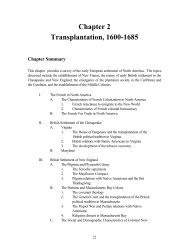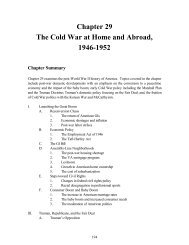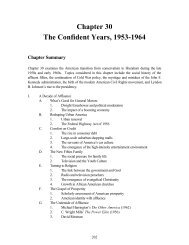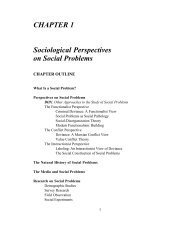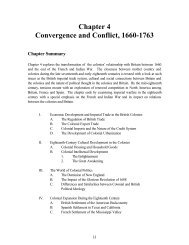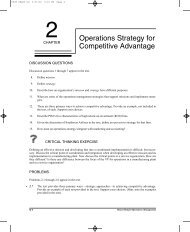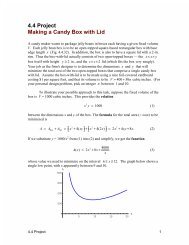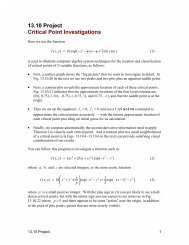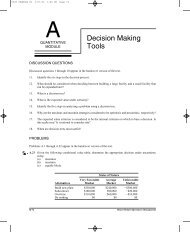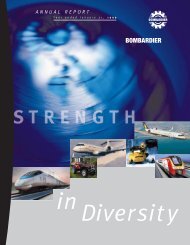Merchandising Operations and the Accounting Cycle - Pearson
Merchandising Operations and the Accounting Cycle - Pearson
Merchandising Operations and the Accounting Cycle - Pearson
You also want an ePaper? Increase the reach of your titles
YUMPU automatically turns print PDFs into web optimized ePapers that Google loves.
278 Part One The Basic Structure of <strong>Accounting</strong><br />
2. Underst<strong>and</strong>ing <strong>the</strong> operating cycle of a merch<strong>and</strong>iser (Obj. 1, 3)<br />
Gayle Yip-Chuck has come to you for advice. Earlier this year, she opened a record<br />
store in a plaza near <strong>the</strong> university she had attended. The store sells compact discs<br />
at very low prices <strong>and</strong> on special credit for students. Many of <strong>the</strong> students at <strong>the</strong> university<br />
are co-op students who alternate school <strong>and</strong> work terms. Gayle allows co-op<br />
students to buy on credit while <strong>the</strong>y are on a school term, with <strong>the</strong> underst<strong>and</strong>ing<br />
that <strong>the</strong>y will pay <strong>the</strong>ir account shortly after starting a work term.<br />
Business has been very good. Gayle is sure it is because of her competitive prices<br />
<strong>and</strong> <strong>the</strong> unique credit terms she offers. Her problem is that she is short of cash, <strong>and</strong><br />
her loan with <strong>the</strong> bank has grown significantly. The bank manager has indicated<br />
that he wishes to reduce Yip-Chuck’s line of credit because he is worried that she will<br />
get into financial difficulties.<br />
Required<br />
1. Explain to Yip-Chuck why you think she is short of cash.<br />
2. Yip-Chuck has asked you to explain her problem to <strong>the</strong> bank manager <strong>and</strong> to<br />
assist in asking for more credit. What might you say to <strong>the</strong> bank manager to assist<br />
Yip-Chuck?<br />
3. Correcting an inventory error (Obj. 6)<br />
The employees of Nor<strong>the</strong>rn Tech Company Ltd. made an error when <strong>the</strong>y performed<br />
<strong>the</strong> periodic inventory count at year end, October 31, 2003. Part of one warehouse<br />
was not counted <strong>and</strong> <strong>the</strong>refore was not included in inventory.<br />
Required<br />
1. Indicate <strong>the</strong> effect of <strong>the</strong> inventory error on cost of goods sold, gross margin,<br />
<strong>and</strong> net income for <strong>the</strong> year ended October 31, 2003.<br />
2. Will <strong>the</strong> error affect cost of goods sold, gross margin, <strong>and</strong> net income in 2004?<br />
If so, what will be <strong>the</strong> effect?<br />
Financial Statement Problem<br />
Closing entries for a corporation that sells merch<strong>and</strong>ise; evaluating ratio data<br />
(Obj. 3, 5)<br />
This problem uses both <strong>the</strong> income statement (consolidated statement of operations)<br />
<strong>and</strong> <strong>the</strong> balance sheet of Intrawest Corporation in Appendix A. It will aid<br />
your underst<strong>and</strong>ing of <strong>the</strong> closing process of a business.<br />
1. Journalize Intrawest’s closing entries for <strong>the</strong> year ended June 30, 2000. You will<br />
be unfamiliar with certain revenues <strong>and</strong> expenses, but you should treat <strong>the</strong>m all<br />
similarly. Make “General <strong>and</strong> administrative” <strong>the</strong> final expense you close.<br />
2. What amount was closed to Retained Earnings? What were dividends in 2000?<br />
3. Intrawest is not a typical merch<strong>and</strong>iser but it does have two types of inventory:<br />
(1) Inventory related to ski operations (Note 7 in <strong>the</strong> financial statements); (2)<br />
Inventory of properties under development <strong>and</strong> held for sale (Note 5). The company<br />
develops resort properties for resale, some of which will be sold in <strong>the</strong> current<br />
year <strong>and</strong> are classified as current assets. The remainder of <strong>the</strong> properties<br />
will be sold in future years <strong>and</strong> are classified as long-term assets. What balances<br />
are reported as current assets on <strong>the</strong> balance sheet for <strong>the</strong> two types of inventory<br />
at June 30, 2000? At June 30, 1999?



